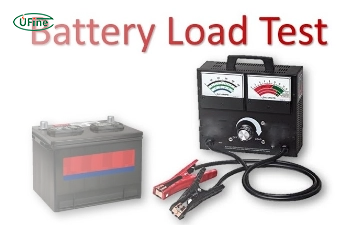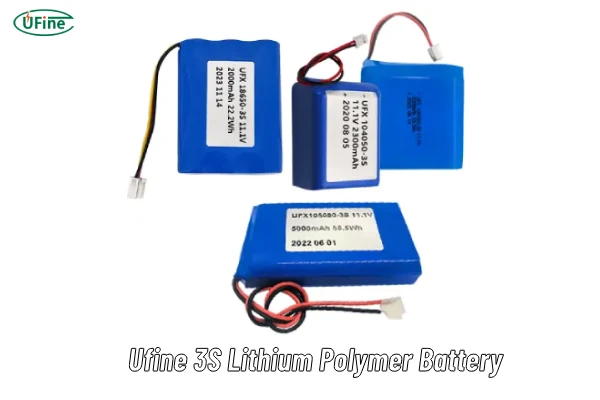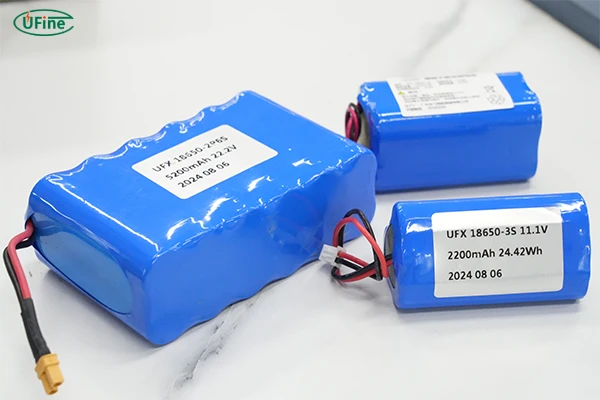
Part 1. What is a 3S lithium polymer battery?
The3S lithium polymer battery represents the ideal balance of lightweight design, high power, and efficiency. It’s especially known for its application in devices that demand high power output with manageable weight. But what makes a 3S battery special? The “3S” stands for three cells in series, each cell carrying a nominal voltage of 3.7V, bringing the total to 11.1V. This configuration provides more power and enables greater performance capabilities than a single-cell battery can deliver, making it a preferred choice for RC (radio-controlled) hobbies, drones, and high-performance gadgets.
When you’re looking to upgrade or power your device, the 3S LiPo battery is a powerful solution. But there’s so much to understand about it—what it’s made of, its strengths, limitations, price, and where to get a reliable battery that truly performs.
Part 2. Basic components
To fully appreciate what a 3S lithium polymer battery can do, let’s look inside it. Its components are carefully designed to balance power and safety. The main components are:
-
Cells: A 3S LiPo battery has three cells in series. Each cell provides around 3.7V, and when combined, they deliver 11.1V, suitable for high-performance devices. These cells are the heart of the battery, storing energy and releasing it when needed.
-
Anode and Cathode: The anode (negative electrode) and cathode (positive electrode) are essential for the charge-discharge process, storing and releasing ions to generate energy.
-
Electrolyte: The electrolyte solution inside each cell is the medium through which lithium ions move between the anode and cathode during charging and discharging.
-
Separator: This thin material between the anode and cathode keeps them from touching and causing a short circuit while allowing ions to pass through.
-
Battery Management System (BMS): The BMS is essential for safe operation, monitoring temperature, voltage, and other factors to prevent overcharging, overheating, and over-discharging, which can damage the battery or make it dangerous.
These components together make up a robust battery that provides consistent power while ensuring safety. A high-quality 3S LiPo battery will use durable materials and incorporate a reliable BMS to enhance both performance and longevity.
Part 3. Shape, size, and weight
A key advantage of LiPo batteries is their flexibility in shape and size. Unlike cylindrical batteries like 18650 cells, lithium polymer batteries can be manufactured in flat, rectangular shapes, making them adaptable for various applications, especially where space is limited.
- Shape: Most 3S LiPo batteries are rectangular, but they can be customized to fit specific devices.
- Size: The size of a 3S battery can vary widely depending on capacity and intended use. Typically, they range from around 130mm to 150mm in length, 40mm to 50mm in width, and about 20mm to 30mm in thickness.
- Weight: Weight depends on the battery’s capacity, with smaller batteries weighing around 100g and larger models closer to 300g. The lightweight design is crucial for applications like drones, where every gram affects flight performance.
When choosing a battery, the shape, size, and weight will be critical factors, especially if you need the battery to fit snugly within a device without adding too much weight.
Part 4. Capacity
Capacity, measured in milliampere-hours (mAh), is a primary indicator of how long a battery can power a device. For 3S lithium polymer batteries, capacities generally range from 1,000mAh to 5,000mAh, though larger capacities exist for specialized applications. Common choices fall between 2,000mAh and 4,000mAh.
A higher-capacity battery lasts longer but often adds weight. In drone applications, for example, you may face a trade-off between runtime and the battery’s effect on weight and flight dynamics. With the right balance, you can achieve impressive flight times without sacrificing too much agility.
Part 5. Pros and Cons
Pros
-
High Power Output: A 3S LiPo battery can handle demanding applications, delivering high power without compromising on efficiency. It’s well-suited for RC vehicles, drones, and similar devices that require bursts of energy.
-
Lightweight: LiPo batteries are lighter than many other types, which is crucial for devices like drones or RC planes that rely on agility and speed.
-
Compact Form Factor: The slim, customizable design of LiPo batteries allows them to fit in tight spaces, making them versatile for numerous devices.
-
Fast Charging: Compared to other chemistries, lithium polymer batteries can be charged quickly with the right equipment, meaning less downtime.
Cons
-
Safety Concerns: LiPo batteries are sensitive to overcharging and physical damage, which can lead to overheating or even fires. They require careful handling and monitoring during charging and storage.
-
Shorter Lifespan: While they perform well, LiPo batteries tend to have a shorter lifespan compared to options like LiFePO4 batteries.
-
Cost: These batteries can be more expensive, especially for high-capacity or high-quality models with added safety features.
-
Storage and Maintenance Needs: LiPo batteries need to be stored at a safe voltage and in stable temperatures to maintain health. They don’t handle being fully charged or fully discharged for long periods.
Part 6. Price
The cost of a 3S LiPo battery can vary, but several factors influence its price:
- Capacity and Size: Higher capacities typically cost more.
- Brand Reputation: Trusted brands that offer high-quality cells and reliable safety features usually charge more.
- Additional Safety Features: Batteries with advanced BMS or safety mechanisms can be pricier.
Price Range: Basic models might start around $20, while high-end 3S LiPo batteries can reach $100 or more. While it’s tempting to go for a cheaper option, investing in a quality battery often means better performance, safety, and longevity.
Part 7. Applications
3S lithium polymer batteries are found in many applications due to their unique advantages:
-
Drones: High capacity, low weight, and substantial power output make 3S LiPo batteries ideal for drones, where agility and flight time matter.
-
RC Vehicles: RC cars, trucks, and boats use these batteries to achieve high speeds and powerful acceleration.
-
Electric Skateboards: The balance of lightweight design and power output makes them suitable for small, portable transport options like skateboards.
-
Model Airplanes: RC planes benefit from the lightweight, compact, and high-energy capacity of 3S LiPo batteries, which allows for longer, more powerful flights.
These applications highlight the versatility of 3S LiPo batteries, showcasing their balance of power and portability.
Part 8. Buy 3S lithium polymer battery: key considerations
If you’re in the market for a 3S lithium polymer battery, certain factors can help you make the best choice:
-
Voltage: Ensure compatibility with your device. A 3S battery provides 11.1V, so double-check your device’s requirements.
-
Capacity: Choose a battery with enough capacity for your needs, balancing runtime with weight.
-
C-Rating: This rating tells you the maximum discharge rate. A higher C-rating is better for devices that demand high bursts of power, like RC cars and drones.
-
Size and Fit: Measure the space in your device to ensure the battery will fit snugly.
-
Safety Features: Look for built-in BMS or other safety features to protect your battery from overcharging or overheating.
Selecting the right battery can feel overwhelming, but by focusing on these factors, you’ll find a reliable 3S LiPo battery that enhances your device’s performance and longevity.
Part 9. 3S lithium polymer battery manufacturer
Ufine Battery is a well-known Chinese manufacturer that specializes in custom lithium batteries, including high-quality 3S lithium polymer batteries. With years of experience and a commitment to innovation, Ufine Battery offers a wide variety of lithium-ion and polymer batteries, including 18550 cells and LiFePO4 batteries, each tailored to meet unique customer needs.
Whether you’re looking for a high-capacity battery for drones or a lightweight option for RC vehicles, Ufine Battery can provide reliable, customized solutions to enhance your device’s performance.
In conclusion, the 3S lithium polymer battery is a powerhouse in the world of portable electronics, blending light weight, power, and versatility. From hobbyists to tech enthusiasts, this battery type has become a favorite in countless applications. Choose wisely, invest in quality, and enjoy the performance boost that only a high-quality 3S LiPo battery can provide.
Related Tags:
More Articles

Battery Load Test: A Comprehensive Guide
Step-by-step battery load test guide for car, solar & industrial use. Learn how to load test a battery, interpret voltage charts, and avoid common mistakes.
The Comprehensive Guide to Battery Balancing and Battery Balancer
Discover how battery balancers improve lithium battery performance, lifespan, and safety. Learn types, functions, and tips to choose the right balancer.
What Is the Best Voltage for a Chainsaw Battery?
Compare 12V-80V chainsaw batteries for light pruning, medium firewood, and professional cutting. See best battery chainsaw with runtime charts and safety tips.
Lithium VS. Alkaline Batteries: A Comprehensive Comparison
Lithium batteries last 3–7× longer than alkaline and perform better in cold weather. Compare lifespan, cost, safety, and best uses to choose the right battery.
Comparing Lithium-Sulfur and Lithium-Ion Batteries: Which is Right for You?
Compare lithium-sulfur (Li-S) and lithium-ion batteries on energy, lifespan, cost, safety, and applications. Best choice for drones, EVs, and electronics.




